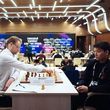Prelude to Confrontation
Dmitry Kryakvin’s report on the closing rounds of FIDE Women's Grand Prix leg in Skolkovo
A home stretch of the tournament must have turned into a real disappointment for the world champion. Not only did Kateryna Lagno convincingly avenged the Chinese for the previous edition's knockout final, the world chess queen was also unable to defeat her two direct competitors.
Ju Wenjun – Goryachkina
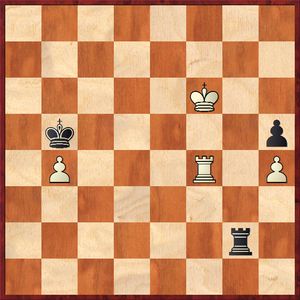
Mark Dvoretzky is no longer with us to let us in the know of errors committed by the leading grandmasters in the rook endings ... I won’t take such responsibility myself but will give you the opinion of two famous grandmasters.
49...Rg1?
“A fantastic game and an incredible finale! Anyone can forget the Vanchura position, which, instead of 49 ... Rg1?, could have arisen after 49 ... Kb6! 50. Rf5 Rg4 51. Rxh5 Rxb4 52. Rh8 (52.Kg5 Kс7!) 52...Ka7! At the same time, this rook ending saw the opponents commit somewhat simple and weird errors. All in all, the defensive proved equal to the offensive. Goryachkina managed to save the unsavable!” (S. Shipov).
50.Rf5+ Kxb4 51.Rxh5 Rh1 52.Rh8 Rf1+ 53.Ke5 Re1+ 54.Kf4 Rf1+ 55.Kg3 Kc5
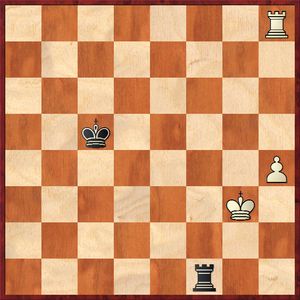
56.h5?
“In this game, Aleksandra Goryachkina showed her resilience to losing, a valuable asset for the world championship match.”
You can put it like this, of course, since papers can't blush, as they say. In my opinion, though, it would be more appropriate to describe the event as follows: “In this game, Ju Wenjun showed an amazing for the world champion “ability” not to win a basic endgame won by primitive means.”
56. Rd8 Rf6 57.h5 Rd6 58.Rd6 Кd6 59.h6 would be easy to calculate even for a third-category player.
However, if we recall Gelfand’s blunder in a similar endgame in the most important game of his world championship match against Anand (even though the game was played in a rapid tie-break), as well as an outstanding endgame “masterpiece” Capablanca - Menchik (Hastings 1929), where the male and female champions demonstrated not only complete ignorance of one of the most important endgames (given in many endgame textbooks of the time), but also the inability to calculate 3-move lines with 5 pieces on the board (2 of them being kings), then the “incident” from today's game between the ladies will no longer seem that big of a surprise.
There comes to memory the immortal: “to err is human” and “Thou shalt not make unto thee a graven image” (O. Korneev)
56...Rh1 57.Kg4?
It is indeed amazing how White managed to refrain from 57.h6 Kb6 58.Kf4? Of course, I would not rush to criticize the opponents and come out with any statements that would sound like anti-advertisement of the upcoming match. All in all, there is no lack of examples that show the high-rated men players blunder in similar positions.
57...Kd6! 58.h6
It is now late for 58.Re8 Kd7 as the black king is not far away.
58...Ke7 59.h7 Kf7 60.Ra8 Rxh7 Draw.
What a disappointment for the Chinese player! In the next game, Ju got a comfortable edge as Black against the tournament leader. For her the victory over Koneru meant a clear first place, but it turned out otherwise...
Koneru – Ju Wenjun
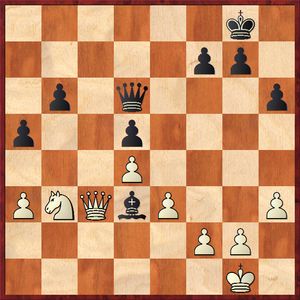
26...Bb5! would have given Black decent chances to succeed as after 27.Qc8+ Kh7 28.Qc2+ Qg6 – Black has a potential passer and the endgame is in her favor, while White has no outpost for her knight.
The leader’s pursuer hurried to “take the bull by the horns,” missing a nice geometry.
26...Qxa3?! 27.Qxd3 a4 28.Qa6!
While 28.Nc5 Qc1+ is underwhelming, the Chinese counted on 28.Qc3 axb3 29.Qc8+ Qf8, giving her an endgame with a passed pawn.
28...Kh7
28...Qxb3 29.Qc8+ Kh7 30.Qf5+ leads to a perpetual check, and the text brings forth the same result.
29.Nc5!
29.Qc8 axb3 30.Qf5+ Kg8 31.Qc8+ Qf8 was not a clear-cut path to a draw, whereas now Koneru has nothing to worry about.
29...bxc5 30.dxc5 d4 31.exd4 Qa1+ 32.Kh2 Qxd4 33.c6 Qf4+ 34.Kg1 Qc1+ 35.Kh2 Qf4+ Draw.
Humpy Koneru has enjoyed brilliant comeback to chess following a break connected with family affairs! Taking into account Hou Yifan’s exclusive appearance in men's competitions (and even that on an infrequent basis), Koneru's chances of storming the female throne look quite substantial. On the other hand, the Grand Prix series is only in its very beginning.
Aleksandra Goryachkina pleased her fans with the last round victory.
Goryachkina – Cramling
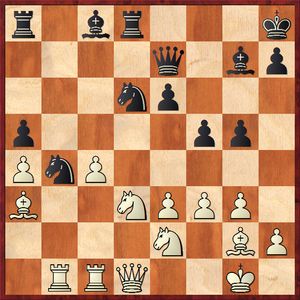
Following 28...Ba6, intending 29.Nxb4 Nxc4, Black could have recaptured the pawn to her advantage, but the Swedish player, exhausted physically and mentally, hurried with premature actions.
28...Nxc4?! 29.Rxc4 Ba6 30.Bxb4 axb4 31.Qb3 Bxc4 32.Qxc4 Rxa4?
Here stronger was 32...Qd6!, not allowing the poorly coordinated white pieces to take the b4-pawn immediately. Now Goryachkina has time to consolidate her position.
33.Kf2! Qd6 34.Rxb4 Ra3 35.Ndc1 Raa8 36.Rb3 Rac8 37.Qb5! Rb8 38.Qd3 Qxd3 39.Rxd3
With many pawns on the board and a compromised pawn structure of Black's, White went on to convincingly prove the superiority of two minors over the rook.
In fairness, Cramling was facing the challenger after suffering a terrible blow from the ex-world champion.
Cramling – Kosteniuk
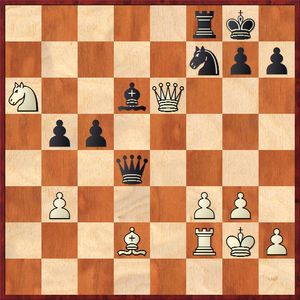
Kosteniuk attacked the strayed white knight with 34...Qa1, which Cramling answered by an immediate resignation! Suggesting itself is 35.Bf4?!, but after 35…Qxa6 36.Rd2 Bxf4 37.Qxa6 Bxd2 38.Qxb5 Bb4 the rook and two minors are likely to prevail over the queen. However, 35.b4! is absolutely risk-free for White!
While feeling sorry for the Swedish player, it has given us yet another excellent tactical exercise. There are upsides and downsides in everything.
Round ten was positive for the Russian players, but the final round met them with failure.
Stefanova – Kashlinskaya
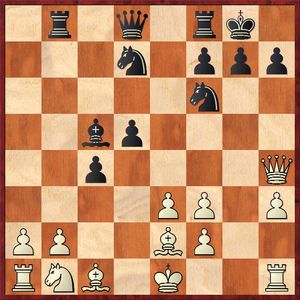
Black has good compensation for the sacrificed pawn.
15.Rg1?!
The white king's central position is likely to be exposed sooner or later. With this in mind, there is no delaying the castling.
15...Re8 16.Nd2?
This move is not good; however, even after 16.Nc3 or 16.Kf1 it is not something to enjoy either.
16...Qa5! 17.a3
The unpinning with 17.Kf1 fails to 17…c3. While Black starts an offensive, the on-looking white queen and rook have no say in this sad action.
17...c3 18.b4 Qa4 19.Bd1
Although 19.Nb3 Qxb3 20.bxc5 Rec8 is somewhat more stubborn a continuation, Black enjoys a substantial edge anyway.
19...c2 20.Be2 Rxb4 21.axb4 Qxa1 22.Nb3 Qc3+ 23.Kf1 Bxb4?!
23...Bb6 is a tougher continuation, and Black should have no problems winning with such a potent passer as the c-pawn. Meanwhile, the d4-knight gives the white pieces some freedom of action, and Black needs time to take care of her king's safety.
24.Nd4 g6 25.f4?
White should have played 25.Kg2 instead; now the white king is in for execution.
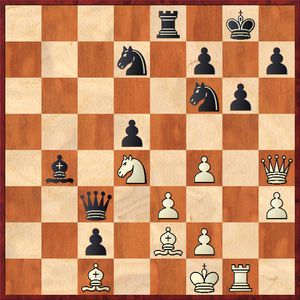
25...Bc5 26.Nf5 d4 27.exd4 Bxd4 28.Qh6
In the case of 28.Qg3 Qa1 29.Qa3 Ra8 the last word belongs to the black passer anyway.
28...Ne4 29.Nxd4 Qxd4 30.Qh4 Nd2+ White resigns.
Gunina – Dronavalli
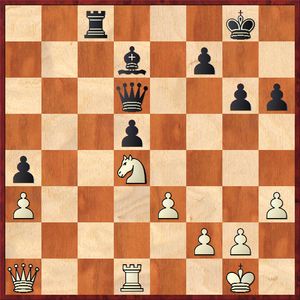
From time to time, Valentina converts a minimum edge so beautifully that you wonder why should she ever have to resort to irrational tricks that she is so famous for. Playing the grandmaster from India, Gunina's performance was reminiscent of 15 - 20 years ago when she was collaborating with Alexander Kalinin. The diagram reminds us of Bent Larsen’s rule in that an isolani should be annihilated rather than blockaded!
34.Ne2 Bb5?
The rook should have been activated via 34...Rc2 35.Nf4 Bc6 since 36.Nxd5? runs into Bxd5 37.e4 Qb6.
35.Nf4
35.Nc3 Bc6 36.Ne4 Qe6 37.Nf6+ Kf8 38.Qd4 Ke7 39.Ng4 h5 40.Ne5 Be8 41.Rb1 looks tempting, but Gunina exercises a practical approach in appropriating a pawn instead.
35...Bc4 36.Nxd5 Bxd5 37.e4 Rc5
Despite Tartakower's caution about the rook endings, White has decent winning chances after: 37...Qc5 38.exd5 Rd8 39.Qa2 Qc3 40.g3 Qb3 41.Qxb3 axb3 42.Rb1 Rxd5 43.Rxb3 – and the king is about to lend support to his passed pawn.
38.Qd4 Rc8 39.exd5 Qxa3
White is up material after 39...Ra8 40.Rd3, which compels Harika to take the a3-pawn as a last resort. On the other hand, Gunina’s passed pawn is now free to move on.
40.d6 Qb3?
A fatal error, while after 40...Kh7 41.d7 Rd8 White yet needed to come up with precise moves.
41.d7 Rd8
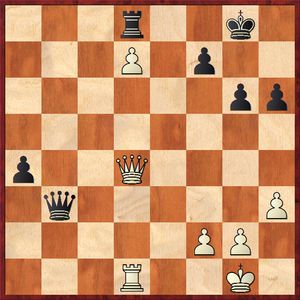
42.Re1!
Now White is in time to regroup and create deadly threats to the f7-square.
42…Qb5 43.Re7 a3
Similar to the game would be 43...Qb1+ 44.Kh2 Qb8+ 45.g3 a3 46.Qd5 Rf8 47.Rxf7, winning.
44.Qf6 Qb1+ 45.Kh2 Qb8+ 46.g3 Rf8 47.Rxf7 Rxf7 48.d8Q+, and White won the game.
Kosteniuk – Stefanova
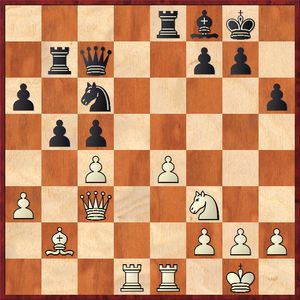
After 23.Rd5 White has decent chances to develop her kingside initiative, but Kosteniuk mistakingly preempts it with the trade of pawns.
23.cxb5?! axb5 24.Rd5 c4 25.Nh4? b4!
An extremely unpleasant stab! The captures on b4 leave White down an exchange, and the alternatives are no better.
26.Qc1 c3 27.Ba1 Ra8, and the с3-pawn had a decisive say in the outcome of the battle.
Kashlinskaya – Paehtz
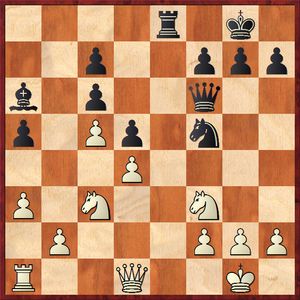
The German chess player must be delighted with her performance in the first stage of the Grand Prix, more so that she managed to take the last-round game. White seems to be in good shape and only needs to put the queen on d2. However, chess is known to be the tragedy of a single tempo!
16...g5!
It brings back Larsen's game against Taimanov. Now that the d4-pawn is doomed, Kashlinskaya is attempting to muddy the waters.
17.Qa4 Bc4
Also not bad-looking is 17...g4 18.Ne5 Nxd4 19.Nxg4 Qf4 20.h3 Ne2+, but Paehtz's choice is more clear-cut.
18.Ne5 Nxd4 19.Nxc4 dxc4 20.Qxc4 Qf4! 21.Qd3
21.Qa6 fails to Qd2, and otherwise the c5-pawn drops.
21...Nb3 22.Qd7 Qe5 23.Rf1 Re6! 24.Qd8+ Kg7 25.h3 Nxc5
A series of precise moves allowed Black getting a huge advantage and pressing it home in the endgame, notwithstanding a desperate resistance from the Russian.
Below is the final standings of the FIDE Grand Prix in Skolkovo.
1. Humpy Koneru (India) - 8; 2-3. Ju Wenjun (China), Aleksandra Goryachkina (Russia) - 7.5; 4. Kateryna Lagno (Russia) - 6.5; 5-6. Valentina Gunina (Russia), Elisabeth Paehtz (Germany) - 6; 7. Dronavalli Harika (India) – 5; 8-9. Alina Kashlinskaya, Alexandra Kosteniuk (both from Russia)- 4.5; 10-11. Marie Sebag (France), Antoaneta Stefanova (Bulgaria) - 4; 12. Pia Cramling (Sweden) - 2.5.
Overall, each leg of Grand Prix has 850 qualification points at stake. This is how they are distributed between the first stage participants:
Koneru - 160
Ju Wenjun - 120
Goryachkina - 120
Lagno - 90
Paehtz - 75
Gunina - 75
Harika - 60
Kosteniuk - 45
Kashlinskaya - 45
Stefanova - 25
Sebag - 25
Cramling - 10




















